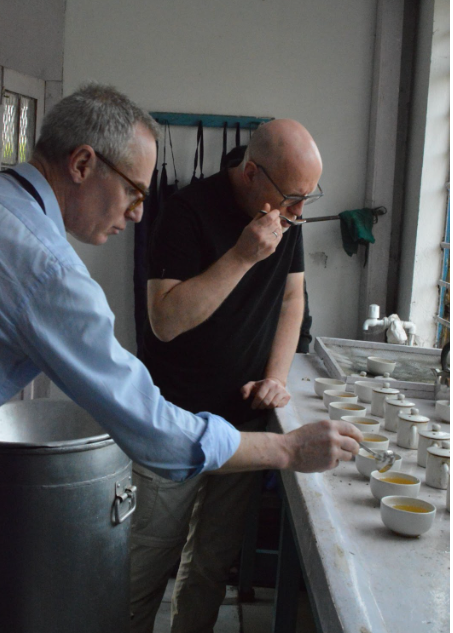I left Tumsong early in the morning to take the high road from Darjeeling across to the Teesta Valley via the Senchal and Tukdah forests. The road rises to 2300m and then follows the ridge almost exactly for around 15 km through the forests, with beautiful views out on either side. Although only around 40 km, it is an almost 3 hour drive along winding and bumpy roads. But surrounded by incredible scenery the time flies by.
There is a dramatic change in scenery when you come over the top into the Tukdah forest. So far in Darjeeling I have been travelling through mainly deciduous forests of oaks, beach, chestnut and needlewood, with coppices of bamboos from time to time. But as we descend into the Tukdah, these are replaced by a predominance of towering, fluffy pine trees, affording views through the trunks across the valley below.

Further down, as we break through the forest line and the landscape opens up to the first, high planted tea estate at Runglee Rungliot, it is like entering an Indian Tuscany. Tall pencil pines surround immaculate tea gardens, dotted with with pluckers villages, and neat tea factories nestled into the hillside. This is definitely worth a visit, if only for the stunning scenery.
As we descend, we pass by the Takdah Orchid Centre, a garden and greenhouses that contain an archive of rare orchid species from around the region. No time on this trip, but I understand well worth visiting.

Further down, as we round a bend, I see a factory with Gielle Estate written across the roof and I find myself getting quite caught up. We have worked with Gielle and Teesta Valley tea gardens now for over 6 years and it is from here that we produce our iconic Royal Flush. In the team the names of these gardens have had almost mythical status. Each year we have tasted 50, 60, 70 different invoices supplied by them, discussed the soil, the altitude and aspect and how this might affect the flavours we are tasting. And here, for the first time, I can see the actual bushes that have produced this amazing leaf and superbly build the flavour of our drinks.

We arrive at Teesta Valley Estate shortly after and are met by Abishek Dev, the CEO of Teesta Valley. Until 2015 he was the Estate Manager here, but then moved to Kolkata to take up the administrative roles in the parent company. But, realising the need to be much closer to the tea, he and his wife have returned to live in the bungalow looking out across the estate.


I am joined at Teesta by Will, our tea merchant who has been my close friend and advisor on tea for 7 years now. Will has been working in tea for over 25 years, and what he doesn’t know about tea is not worth knowing. So much so that he wrote the World Atlas of Tea, a great read for anyone that wants to dig more into the world of tea.

The tea gardens I have visited over the past few days are all high altitude gardens so are late to start picking. So the factories have been dormant, waiting for the first teas of the year to arrive in the coming days.
So at Teesta, this is the first time I am walking into a factory where tea is already being processed. And the experience is heady. We climb to the top of the factory and as we step through the door of the withering room are hit by an exquisite, rich, pungent, sweet, floral aroma of the green leaf. Notes of green grapes, asparagus and honeysuckle hit you. I wish I could bottle this and take it home as it is really difficult to describe what an amazing experience this is.

The leaf has already been withering for a few hours so is soft and pliable, but probably still has a moisture content of around 70-75%. On the bush, depending upon the weather conditions, the leaf may have over 80% moisture. And before rolling, the withering process must drop the moisture to around 55-60%. This will take around 14-16 hours. Each garden does this slightly differently and it is the expertise of the team to know just when the tea is ready.

The leaf is still a vivid green at this point, full with a combination of leaf, tips and stalk.
From the original weight of fresh green leaf, only about 22-25% of the weight will be remaining when it is packed. The majority of this weight loss will be the removal of moisture, but some stalk and dust as well.
In Darjeeling, the flavour of the tea is significantly affected by the terrain, but also the specific clone of Camellia sinensis var. Sinensis. In Darjeeling, they talk about the original plantings originating from Robert Fortune’s tea explorations as “China” and all other clones as “Clonal”.
These clonal varieties have been created by the Tea Research Association, in collaboration with many of the tea estates. The TRA studies the characteristics and performance of certain bushes on different estates over the space of many years to identify certain characteristics: flavour, drought tolerance, leaf form, yield, hardiness etc. Once they have identified plants with special characteristics that can be useful to the planters, cuttings are take from these bushes and propagated in order to create a new clonal “variety” with names such as AV2, B136 etc., the letter signifying the estate that the original plant came from.
More rare, but there are also bi-clonals which are propagations of two plant graftings.
These clonals are enabling Darjeeling to constantly evolve their crops and create specific blends that meet their customer’s needs. Most estates will still have a majority China bushes, but as they replace and infill, different clonals are used in different zones. So when the tea is picked, it is marked by its type. At the end of the sorting process, these batches are then blended in order to give the flavour profile required.
So when we are searching out our teas, we are not only conscious of the lay of the land, but also clonal blend created. It is quite extraordinary the impact this can have on flavour, and always exciting to taste one that you have not come across before.
And from tasing comes lunch, another great tea bungalow tradition, and no lesser of a heady tasting experience. It is going to be really hard to go back to our local British version of Indian food again after the delicacies of this trip.

